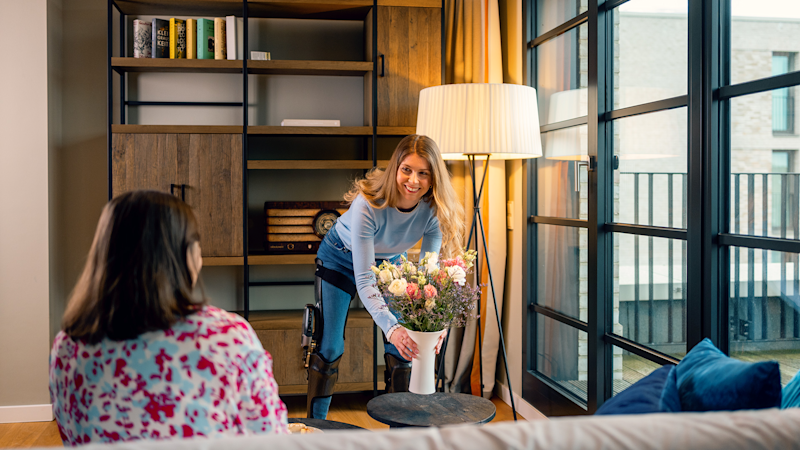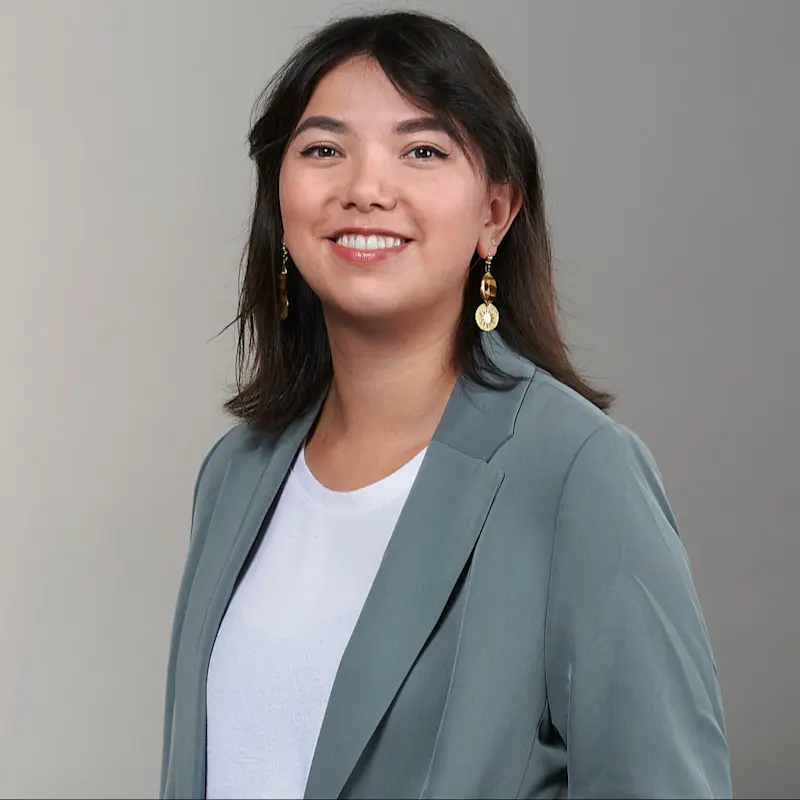Ayleen’s path to an upright life: Fighting barriers with technology and courage
Thanks to special high-tech orthoses, the paraplegic from Marburg can walk again and travel the world. Today, she shares her experiences with those affected – and fights against taboos and for more information.

Thursday, 15 August 2024
Ayleen (29) has been paraplegic in both legs since 2020 due to a chronic spinal disease.
Her special mission: as a speaker , she advocates the representation, inclusion, de-tabooing and empowerment of people with disabilities – whether in relation to the challenges of paraplegia or blind spots in medical care
She also supports others as a volunteer dying companion in the hospice service for children and adolescents.
The economist, who has a degree in economics, campaigned for her own treatment. Today she wears the C-Brace orthosis on both legs and uses the Exopulse Mollii Suit electrode suit to combat spasticity – and only rarely uses a wheelchair as a supplement now.
Her mix of devices gives Ayleen the opportunity to travel the world and be in nature again – to places that are not barrier-free and have been denied her for a long time.
Ayleen W. from Marburg lives with various chronic diseases, which also affect her spine. She has been in hospital a lot since her very early childhood. Time and again, her survival was at risk. But the now 29-year-old has learnt to live with her diseases. She travels, studies abroad, works as a swimming trainer, volunteers and undergoes training to become a dying companion and grief counsellor at the hospice for children and adolescents. “I knew that if my back was okay so far and I was able to get along, I wanted to experience everything I could,” she recalls. Then, in 2020, her illness got worse and her world became very small from one moment to the next: “I was in my mid-twenties, everything looked stable and suddenly broke away.”
Between rehab bed and wheelchair
Paraplegia was Ayleen's finding. This made her one of over 140,000 people in Germany who have limited or no mobility in one or both legs.(1) “It was like a slap in the face. I had reached maximum independence and suddenly needed help, for example with showering and transferring from the toilet to the wheelchair. I thought that I would get all the information I needed in rehabilitation,” says Ayleen. “But that’s how you can be mistaken.”
She waited several weeks for a wheelchair. When she saw another patient in the rehabilitation centre who had leg orthoses, she asked whether such devices could also be an option for her. But her question about rehabilitation using orthoses was dismissed. She was told that she needed to get used to using a wheelchair first, and orthoses could be considered in three to five years. Instead of medical support for treatment with an orthosis, she was advised to take psychological care and made aware that she had to face reality: The chances of getting orthoses were reveries.
“This is completely the wrong approach. The more time is lost before the appropriate treatment is provided, the less likely it will be to be a success,” explains Ayleen, who has now gained a great deal of expertise for her disease. Alexander Hardt, Market Manager NeuroMobility at Ottobock, confirms her experience: “About half of people with incomplete paraplegia are treated with a wheelchair, even though they would be more mobile with the appropriate orthoses.”
Ayleen’s long journey to mobility with the C-Brace
After finishing rehabilitation, the economics graduate researched on the Internet until she got the information she needed so badly. She arranged an appointment with an Ottobock O&P professional in Göttingen to test the high-tech C-Brace orthosis.
The microprocessor-controlled knee joint orthosis continuously monitors the flexion angle in the knee joint using sensors that record the entire gait cycle every 0.01 seconds. Unlike other orthoses, which keep the leg permanently extended and can abruptly flex the knee only by releasing a mechanism, the C-Brace adjusts extension and flexion in real time, thereby enabling a dynamic gait pattern.
“Our goal is to help people with lower limb paralysis regain new mobility and give them back a bit of their quality of life with the C-Brace. Medical supply companies, O&P professionals, physiotherapists and doctors need to work closely together to achieve this – and of course the affected individuals themselves as well,” says Alexander Hardt. “We also continually conduct scientific studies to prove effectiveness and continually improve devices according to the needs of the users. For example, study results from 2023 show that the microprocessor technology in the C-Brace makes a significant and clinically important contribution to improving balance and reduces falls by up to 80 per cent. This is particularly relevant for the approval process for orthoses.”
Ayleen has shown great staying power in the approval process: “We keep the competence of doctors very, very high in Germany. But when a doctor prescribes a device, the health insurance experts suddenly question it.”
Finally, nearly two years later, in January 2023, Ayleen was fitted with the C-Brace on a permanent basis. One orthosis for each leg put her back on her feet – even though it was almost too late because her musculature had already regressed. This was huge progress for the young woman: she is finally able to walk upright again and isn’t entirely dependent on a wheelchair. Stairs are no longer insurmountable barriers to everyday life, and participation in social and community life is less restricted.
Back to nature: jungle safari with paraplegia
The example of Ayleen shows that chronic diseases and disabilities are dynamic. She herself uses a combination of devices to manage her day-to-day life. She wears the leg orthoses whenever possible because that lets her be most mobile. She also uses the Exopulse Mollii Suit, which she wears every 24 hours for one hour in consultation with her doctor. Light stimulation by 58 electrodes prevents spasticity and has additional positive side effects: For example, Ayleen can sleep more relaxed again, stop taking her tablets, and her bowel function has improved. And when she needs a break in her day-to-day life, she uses a wheelchair. This mix is tailored to her specific needs – and gives her a sense of security.
The devices are continually being developed just as dynamically, reports Alexander Hardt: “For example, the additional knee joint to guide the C-Brace for patients weighing up to 110 kg was relocated from the inner side of the leg (medial) to the outer (lateral). This means people with a bilateral treatment like Ayleen can wear the orthoses more effectively.”
Ayleen’s highlight so far: a trip to India lasting several weeks. With the C-Brace, it was even possible to go on a safari through the middle of the jungle, past families of elephants and across a river on a raft. This journey would have been unthinkable in a wheelchair. “That was a little outburst of courage. It is precisely these experiences in nature that are very special. Obviously, nature is not barrier-free at all, especially in Europe or India. In the USA, you often see trails that have been adapted for wheelchairs. But with the C-Brace, a large part of the world is simply open to me again.” Next on her bucket list is Vietnam, Cambodia or South Africa to experience and get to know people and nature.
Discrimination in the workplace: How Ayleen breaks down barriers and encourages others
There were also unexpected professional hurdles for her working as a data analyst in an IT company at that time, such as the refusal to allow her to work more days from home – even though she was only mobile in a wheelchair at that time and her workstation was inaccessible due to steps. Something that Ayleen finds – in addition to discrimination – incomprehensible: “We can do many jobs from home, yet we do not see a significant increase in the share of employees of severely disabled people. Unfortunately, not much has happened, even though the home environment is usually the most accessible area a disabled person has.” Particularly in times of a historical shortage of skilled workers, potential and workforce are being wasted due to prejudices, uncertainties and stigmatisation.(2)
Today, Ayleen is working as a speaker and via social media to close this information gap. She visits hospitals, visits community meetings, talks to patients about symptom management and application procedures and leads workshops to raise awareness in dealing with patients. Her goals in raising awareness: Building bridges, giving courage, taking the topic out of the taboo zone so that people with disability are included and are not discriminated against.
Structural change starts with dialogue
For the future, Ayleen hopes above all for structural changes. She believes that the process for providing patients with devices needs to be shortened so that people get the right individual products and the corresponding physiotherapy for using them in good time. This also goes hand in hand with the desire for greater acceptance of the needs and situations of people with chronic diseases or disabilities. And that includes removing barriers to the labour market. “The only way to counter these many uncertainties and fears is by actively engaging in dialogue and talking to each other,” says Ayleen.
Overview: C-Brace® from Ottobock
The world’s first computer-controlled leg orthosis with intelligent sensors in the knee joint
Custom fabricated thigh, lower leg and foot components
For people with symptoms of paralysis of the legs up to incomplete paraplegia
Dynamic control of the entire gait cycle in real time thanks to SSCO® technology (Stance and Swing Phase Control Orthosis)
Enables more natural and controlled movement patterns when walking, sitting down and climbing stairs and expands range of motion
Can handle uneven ground, slopes and stairs
Requires fewer compensating movements and less physical exertion – secondary damage is reduced
Inconspicuous to wear – also under clothing
High-performance battery lasts all day when fully charged
User-defined mode, e.g. for cycling, configurable via smartphone app
Sources


